NVIDIA GeForce GTX 670 Review Feat. EVGA: Bringing GK104 Down To $400
by Ryan Smith on May 10, 2012 9:00 AM ESTOC: Power, Temperature, & Noise
Our final task is our look at GTX 670’s overclocking capabilities. Based on what we’ve seen thus far with GTX 670, it looks like NVIDIA is binning chips based on functional units rather than clockspeeds. As a result GTX 670 could have quite a bit of overclocking potential, albeit one still limited by the lack of voltage control.
| GeForce 600 Series Overclocking | |||||
| GTX 670 | EVGA GTX 670SC | GTX 680 | |||
| Shipping Core Clock | 915MHz | 967MHz | 1006MHz | ||
| Shipping Max Boost Clock | 1084MHz | 1188MHz | 1110MHz | ||
| Shipping Memory Clock | 6GHz | 6GHz | 6GHz | ||
| Shipping Max Boost Voltage | 1.175v | 1.162v | 1.175v | ||
| Overclock Core Clock | 1065MHz | 1042MHz | 1106MHz | ||
| Overclock Max Boost Clock | 1234MHz | 1263MHz | 1210MHz | ||
| Overclock Memory Clock | 6.9GHz | 6.6GHz | 6.5GHz | ||
| Overclock Max Boost Voltage | 1.175v | 1.162v | 1.175v | ||
Because of the wider gap between base clock and boost clock on the GTX 670 we see that it doesn’t overclock quite as far as GTX 680 from a base clock perspective, but from the perspective of the maximum boost clock we’ve slightly exceeded the GTX 680. Depending on where a game lands against NVIDIA’s power targets this can either mean that an overclocked GTX 670 is faster or slower than an overclocked GTX 680, but at the same time it means that overclocking potential is clearly there.
We’re also seeing another strong memory overclock out of a GK104 card here. GTX 680 only hit 6.5GHz while GTX 690 could hit 7GHz. GTX 670 is only a bit weaker at 6.9GHz, indicating that even with the relatively small PCB that NVIDIA can still exceed the high memory clocks they were shooting for. At the same time however this is a luck of the draw matter.
The EVGA card meanwhile fares both worse and better. Its gap between the base clock and and maximum boost clock is even larger than the reference GTX 670, leading to it having an even lower overclocked base clock but a higher overclocked maximum boost clock. The real limiting factor however is that it couldn’t reach a memory overclock quite as high as the reference GTX 670 – again, luck of the draw – which means it can’t match the overclocked reference GTX 670 as it’s going to be more memory bandwidth starved more often.
Moving on to our performance charts, we’re going to once again start with power, temperature, and noise, before moving on to gaming performance. We’ll be testing our GTX 670 cards at both stock clocks with the maximum power target of 122% (170W) to showcase what is possible at validated clockspeeds with a higher power cap, and a true overclock with a maximum power target along with the largest clock offsets we can achieve.
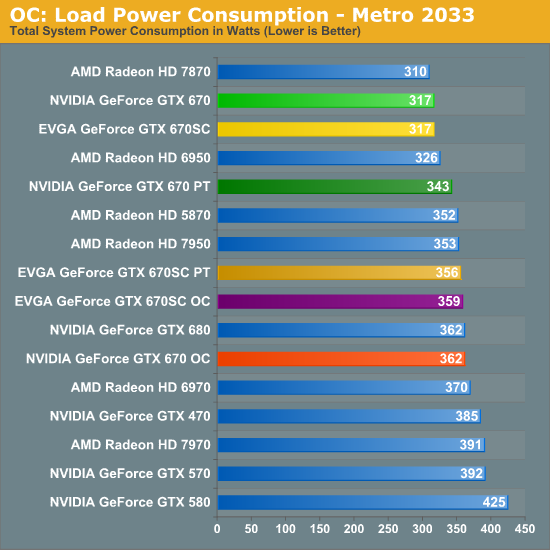
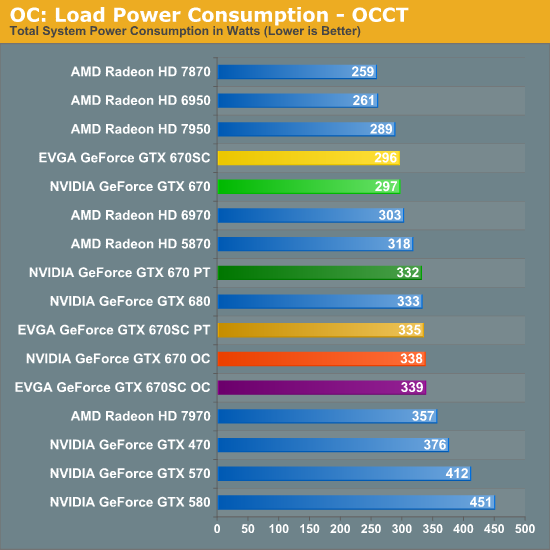
Not surprisingly, since we’re almost always operating within the realm of the power target as opposed to the TDP on the GTX 600 series, our power consumption closely follows our chosen power target. Cranking up the power target on the GTX 670 for example to 170W puts us within 6W of the GTX 680, which itself had a 170W power target in the first place. This is true for both Metro and OCCT, which means power consumption is very predictable when doing any kind of overclocking.
This also means that power consumption is still 18W-30W below the 7970, which in turn means that if these overclocks can close the performance gap, then the GTX 670 still has a power consumption advantage.
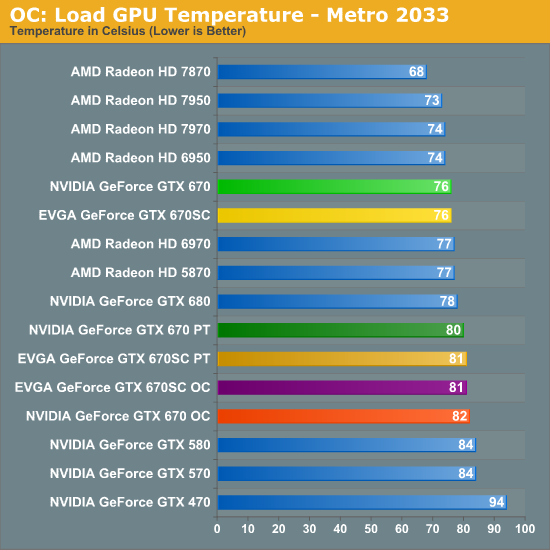
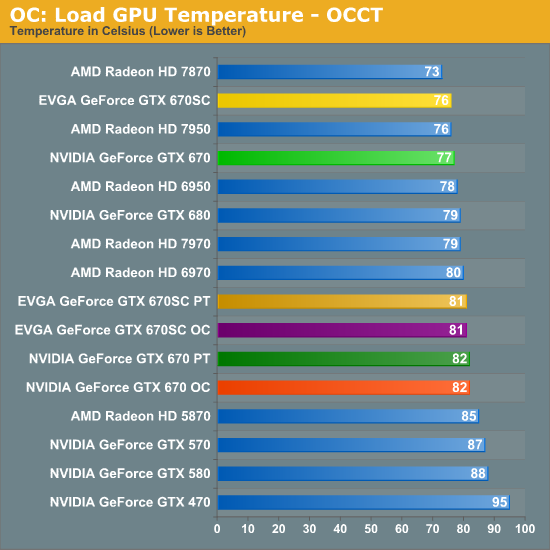
As to be expected, with an increase in power consumption comes an increase in load temperatures. However the fact that we’re only able to increase power consumption by about 30W means the temperature rise is limited to 4-5C, pushing temperatures into the low 80s. This does end up being warmer than the equivalent GTX 680 however due to the 680’s superior heatsink.
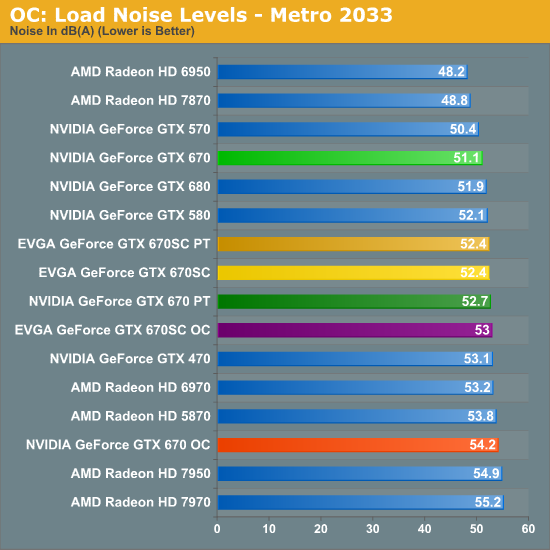

Finally, when it comes to noise we’re also seeing the expected increase, but again it’s rather small. Under Metro the amount of noise from the reference GTX 670 rises by under 3dB when pushing the power target higher on its own, while it rises 3dB when adding in our full overclock. Again the smaller cooler means that the GTX 670’s fan has to work harder here, which means our gaming performance may be able to reach the GTX 680, but our noise is going to slightly exceed it. As a point of reference, in the process we’ll also exceed the GTX 580’s noise levels under Metro. Still, in both OCCT and Metro none of our GTX 670 cards exceed the Radeon HD 7900 series, which means we've managed to increase our performance relative to those cards without breaching the level of noise they generate in the first place.










414 Comments
View All Comments
warmbit - Tuesday, July 17, 2012 - link
If you want to see what we really have GTX670 performance in games is worth taking a look at this overview:http://warmbit.blogspot.com/2012/05/analiza-wyniko...
On the right side, select your language for translation (Google Translate).
Gastec - Tuesday, November 13, 2012 - link
These are the comments of people reading AnandTech articles? Gamers? Enthusiasts? WHERE?? A bunch of trolls barking at each other. Not one useful comment, not even one to express USER oppinion after USING the card for a while. NOT ONE to say if the colors look better or worse than on the last generation card or the competition ones. You are all just a bunch of ....spit on you trolls!Gastec - Tuesday, November 13, 2012 - link
I've been holding this question unaswered in me for years. I would like to know which card produces the best image quality given the same conditions and settings, a nVidia one or Ati/AMD one. Image quality as in the closest to reality or closest to what the image producer indended. And If I get an aswer I want it argumented, no "because it has PhysX!" "because it rocks!" childish like considerations. Picture examples would be greatly apreciated. Thank you, have a good day and try not to troll too much.Gastec - Tuesday, November 13, 2012 - link
It had to be like that of course. Always against me. Two games I want to play,only two I don;t care about the others: Crysis and The Elder Scrolls V: Skyrim. And what do I see?? nVidia will work on one but not the other, AMD will work on the other one but not on the first one. What the f...k is that!?? What card should I get and why? Pictures please. Money is a concern.